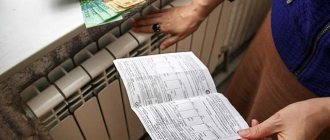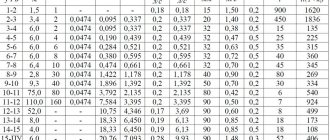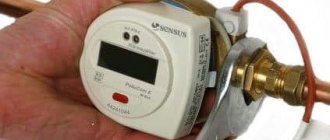What is Gcal?
We should start with a related definition. A calorie refers to the specific amount of energy required to heat one gram of water to one degree Celsius (at atmospheric pressure, of course). And due to the fact that from the point of view of heating costs, say, at home, one calorie is a tiny amount, gigacalories (or Gcal for short), corresponding to one billion calories, are used for calculations in most cases. We've decided on this, let's move on.
The use of this value is regulated by the relevant document of the Ministry of Fuel and Energy, published back in 1995.
Note! On average, the consumption standard in Russia per square meter is 0.0342 Gcal per month. Of course, this figure may vary for different regions, since everything depends on climatic conditions.
So, what is a gigacalorie if we “transform” it into values that are more familiar to us? See for yourself.
1. One gigacalorie is equal to approximately 1,162.2 kilowatt-hours.
2. One gigacalorie of energy is enough to heat a thousand tons of water to +1°C.
Heating charges: how to check whether the charges are correct?
18.02.2021
Heat / Heating, heat supply - payment
Mikhail Kozyrev
With the beginning of each heating season, residents of apartment buildings again and again have a question: on what basis do we pay “for heat?”, “Is it too much?” and “how to check the correctness of heating charges?”
Also, heating fees are the most incomprehensible part of utility bills for citizens. The receipts we receive have the line “Heating”. It contains a meaningless unit of measurement - “gigacalories”. And the figure in the column “volume of services provided” is even less meaningful to us.
What services? How are they counted? What do calories have to do with it? And where does the number of them come from, which for some reason is attributed to your apartment? Let's figure it out.
But let’s say right away that the calculation of the amount you have to pay for heat follows rather complex rules. They involve a lot of formulas and take some time to figure out.
Therefore, we suggest you act this way: first, let’s look at the logic of the calculations as a whole, you will be able to understand which option applies to your home. And then we’ll go through the formulas used to calculate the heating fee in each specific option.
How are heating charges calculated? General logic
So, let's start with “calories”, or rather Gigacalories (Gcal). These are units of measurement of thermal energy. It, thermal energy, is supplied to your apartments through a coolant - i.e. water heated to the required temperature.
Passing through the heating system of the house, the coolant gives up some of its energy and makes the radiators and risers in your apartment hot. Therefore, it is natural that the volume of heat that enters our house is measured in Gcal.
Let's move on... How do we know how many Gcal are in our apartment?
If you have a heat meter in your apartment, then answering this question is relatively simple. The amount the meter counted is the amount consumed. Plus, we need to add that part of the heat that goes to heating stairwells, elevator lobbies, etc. This is called heat for general house needs. We will indicate below how its volume is calculated.
In general, we can say that using an apartment heat meter, calculating the volume of your consumption is, of course, easier than that. The problem, however, is that heat meters began to be installed in apartments in high-rise buildings quite recently and few people have them installed now. However, there are such people, and the current legislation clearly describes how they can calculate their payment. We will look at this in detail.
A much more common case is when the heat meter is located at the “entrance” to an apartment building. Such a meter is called a common or collective meter. Its readings make it possible to understand how much heat has entered the house. Then you can calculate what part of this energy falls on each apartment.
The distribution in this case occurs in proportion to the area of the apartments. This calculation seems quite logical. We provide all the necessary formulas below.
Well, what happens if there is no communal heat meter? We answer: the calculation is carried out according to heating standards. The standard in this case is the calculated amount of thermal energy that is needed to heat one square meter of housing for a month. They are measured in Gcal per square meter. meter.
Since our temperature regime in winter in different parts of the country is very different, heating standards are determined by regional authorities and differ in different regions of the federation. In addition, different standards may be established for different types of housing. Which is quite logical - the heat loss in an old barracks and a relatively modern 11-story building built in the 80s is, of course, different.
The algorithm for calculating heating fees according to standards is quite simple. The area of your apartment is multiplied by the current standard, the result is the amount of thermal energy that (theoretically) is needed to keep you warm. Naturally, all these calculations are somewhat speculative and often do not correspond to the actual consumption of thermal energy.
Our government has been stubbornly struggling with heating fees according to standards for some time now. The installation of communal heat meters is recognized as mandatory. And if there is no common house meter (although there is a technical possibility for installing one), then the heating fee will be charged with “penalty” coefficients. From January 1, 2017 it is 1.5. Details of the calculation according to the standard are also given below.
For now, let's summarize. The figure that describes the amount of heat consumed on your bill may appear in one of three ways:
- based on the readings of your apartment heat meter (plus your share of heat consumption for general house needs)
- based on your share of the common house heat consumption (calculated using the common house meter)
- based on heating standards, if your house does not have a communal meter.
Another important clarification: according to current legislation, heating fees can be calculated:
- during the heating season only
- throughout the year
Which of these options to follow is up to the regional authorities to decide. If a decision is made to charge heating fees throughout the year, then special correction factors are used in the formulas for calculating heating fees. We will talk about them below, in the section where formulas are discussed.
Here we note one important thing regarding payments for heat throughout the year: if you pay for heat in the summer months, and your house has a communal heat meter, then you must make an annual adjustment payment for heating.
Just make a note of this, we will return to this in more detail below.
Now that we have generally figured out how the heat payment is calculated, let’s move on to the formulas that describe exactly what your payment should be.
How is the heating fee calculated if payments are received only during the heating season?
Currently, the cost of heating services is calculated on the basis of the “Rules for the provision of utility services to owners and users of premises in apartment buildings and residential buildings”, approved by Decree of the Government of the Russian Federation No. 354 of May 6, 2011. The current version of this document can be viewed here.
To avoid confusion in the future, we will simply call this document “Rules”.
Let us clarify once again that if you are charged for heat only during the period October - May, then everything written in this section applies specifically to you. If, in your case, payments for heat come monthly, including in the summer, then immediately go here.
Let's move on directly to calculating heat charges. Their algorithm, as we wrote above, depends on the following factors:
- presence of a common house meter in the house
- availability of apartment (individual) heat meters in all apartments and non-residential premises of the house
- and also (we didn’t write about this above, but now we’ll bring you up to date) from the presence of so-called “distributors” in at least 50% of the residential (and non-residential) premises of an apartment building
Let's look at each of these points.
Option 1. A communal heat meter is not installed in your house.
In this case, the heating fee is calculated based on three parameters:
- the heating standard approved in your region, how many gigacalories (Gcal) are needed to heat one square meter for a month
- heating tariff approved for your heat supplier, i.e. how much does one Gcal cost?
- area of your apartment (we remind you that the heated area does not include the area of the loggia or balcony).
The formula that describes the calculation of heating fees in the absence of an individual (apartment) and communal meter looks like this:
| Pi=Si x Nt x Tt |
Where:
Si is the total area of i residential or non-residential premises.
Nt is the consumption standard for the heating utility service.
Tt is the tariff for thermal energy established in accordance with the legislation of the Russian Federation
In other words, the area of your apartment is taken, multiplied by the heating standard (how many gigacalories are considered necessary to heat one square meter of area) and multiplied by the heat tariff in force in your region (the cost of one gigacalorie).
It is also worth considering that if you do not have a common building heating meter in an apartment building, although there is a technical possibility for installing one, then when calculating the heating fee, a multiplying factor is applied. Thus, the government encourages building management organizations and residents to install communal metering devices.
The value of this increasing coefficient for 2021 is assumed to be 1.4. And from January 1, 2021 - 1.5.
The coefficient does not apply if there is a House Inspection Report, during which it was recognized that it was not technically possible to install a collective (house-wide) heat energy meter.
Option 2. There is a general building heat meter, but heating meters are not installed in the apartments
It is worth noting that the formula below only applies if none of the apartments in the building are equipped with an individual heat meter. If so, then the calculation is as follows:
| Pi = Vd x Si / Sob x Tt |
Where:
V d - volume (quantity) of thermal energy consumed during the billing period, determined according to the readings of the collective (common house) thermal energy meter with which the apartment building is equipped.
Si - total area of the i-th residential or non-residential premises
S o b - the total area of all residential and non-residential premises of an apartment building
Tt - tariffs for thermal energy established in accordance with the legislation of the Russian Federation.
To simplify, we take the total volume of heat consumed in an apartment building.
It determines the share attributable to your apartment (based on the ratio of the total area of the house and the area of the apartment).
The resulting amount of heat in gigacalories is multiplied by the tariff in force in your region.
Option 3. The general building meter is installed; all apartments (non-residential premises) are equipped with individual heat meters.
“all ” (100%) apartments and non-residential premises are equipped with heat meters
In this case, the following formula applies:
| Pi = (Vin+ Viodn x Si / Sob) x TT |
Where:
Vi n - volume (quantity) of a communal resource consumed during the billing period in the i-th residential or non-residential premises, determined according to the readings of an individual or general (apartment) meter in the i-th residential or non-residential premises.
Vi one - the volume (quantity) of thermal energy provided during the billing period for common building needs in an apartment building equipped with a collective (common building) heat energy meter.
This volume of heat for general house needs is calculated, in turn, using the following formula:
Viodn = Vd — ∑iVin
Si is the total area of the i-th room of an apartment building
Sob - the total area of all residential premises (apartments) and non-residential premises in an apartment building
TT is the tariff (price) for a utility resource (in this case, for thermal energy), established in accordance with the legislation of the Russian Federation.
The point is that the amount of heat consumed in the apartment is taken (based on the readings of the apartment meter) and the part of the general building heat consumption that passes through this apartment is added to it.
The resulting figure is multiplied by the current heating tariff.
Option 4. The communal meter is installed; at least one, but not all, apartments are equipped with individual heat meters
In this case, payment for heating is carried out in the following form:
| Pi = (Vi+Si x (Vd-∑Vi)/Sob) x TT |
Where
Si is the area of the apartment,
VD – volume of consumption in the house, calculated using a common house heat meter,
Sob – the total area of all residential and non-residential premises in an apartment building,
TT – heat tariff,
Vi is the heat consumption in the apartment in question. If a heat meter is installed in it, then the volume of consumption according to the meter is meant.
If we are talking about an apartment that is not equipped with a heat meter, then its consumption is calculated using a separate formula:
Vi = Si x ∑VIPU/∑SiIPU,
In other words, to calculate the volume of heat, the average volume of heat consumption per square meter in apartments equipped with heat meters is taken and this average reading is multiplied by the area of the apartment in question. Those. the average heat consumption, which was calculated for apartments with meters, is extrapolated to apartments without meters.
In general, Option 4 assumes that the share of heat consumption for general house needs per room is added to the heat consumption in the apartment. This volume is proportional to the ratio of the area of a given apartment and the sum of the areas of all residential and non-residential premises.
As you can see, the principle is the same as when calculating heating fees in houses where all apartments are equipped with individual heat meters.
Option 5. Payment for heat in an apartment building where more than 50% of apartments are equipped with distributors
The distributor is a sensor that is installed on the heating battery (outside) and takes into account the amount of heat that the battery releases into the environment. In other words, it is an analogue of a heat meter, operating on different principles.
The rules require utility companies to take readings from distributors to calculate heating fees. It is only necessary that two conditions be met:
- a high-rise building must be equipped with a common building (collective) heat meter
- distributors must be installed in apartments that collectively occupy an area of more than 50% of all residential and non-residential premises of the house
If these conditions are met, then once a year (and more often by decision of the meeting of residents), the payment for heating apartments with distributors is adjusted based on the readings of these devices.
The formula in this case is as follows:
Where:
Pi - the amount of payment for the provided heating utility service in the i-th residential premises (apartment) equipped with distributors or non-residential premises in an apartment building for the period for which the adjustment is made,
k is the number of residential premises (apartments) and non-residential premises in an apartment building equipped with distributors, p is the number of distributors installed in the i-th residential premises (apartment) or non-residential premises in an apartment building;
mqi - the share of the volume of consumption of the heating utility service attributable to the qth distributor installed in the i-th residential premises (apartment) or non-residential premises in an apartment building, in the volume of consumption of the heating utility service in all residential premises (apartments) equipped with distributors and non-residential premises in an apartment building.
The meaning of this formula is:
- the entire heating fee is taken, which (based on the standards, according to the formula of Option 2) was paid by the apartments where the distributors are installed
- the share of each of your distributors in the volume of heat that was taken into account by the distributors in all apartments is calculated
- then these shares are summed up and thus your share in heat consumption among all apartments equipped with distributors is calculated
- We multiply the total amount of payment for heat by all apartments with distributors by your share in this consumption (judging by the readings of the distributors).
- the resulting figure will be your payment for heat for the adjusted period.
If it turns out to be more than you have already paid, future heat payments will be counted towards you. If it is less, an additional adjustment payment will be issued.
How is the heating fee calculated if payments are received throughout the year?
In this case, heating fees are charged throughout the year in equal installments. The algorithm for calculating payments here will also depend on
presence/absence of a common house heat meter
presence/absence of individual heat meters in apartments.
At the same time, if the house has a common metering device, then the residents must make annual adjustments to the heating charges.
So, let's look at possible options for charging heating fees.
Option 1. The house has neither communal nor individual heat meters
In this case, the payment for heating in the i-th room (apartment) is calculated according to the standards. The calculation formula is:
| Pi = Si x (NT x K) x TT |
Where:
Si is the total area of the i-th room (apartment) in an apartment building or the total area of a residential building (sq. m);
NT - standard heat energy consumption for heating (Gcal/sq. m);
K is the coefficient of frequency of payments by consumers for heating utilities, determined by dividing the number of full months of the heating period in a year by the number of calendar months in a year.
TT is the tariff for thermal energy established in accordance with the legislation of the Russian Federation (RUB/Gcal);
At the same time, if you do not have a common building heating meter in your apartment building, but you have the technical ability to install it, then an increasing factor will be applied when calculating the heating fee.
The value of this coefficient for 2021 is assumed to be 1.4. And from January 1, 2021 - 1.5.
The coefficient does not apply if there is a House Inspection Report, during which it was recognized that it was not technically possible to install a collective (house-wide) heat energy meter.
Option 2. A general house heat meter is installed in the house; apartment heat meters are not installed in all apartments and non-residential premises
In this case, the heating fee is calculated using the following formula:
| Pi = Si x VT x TT |
Where:
Si is the total area of the i-th room (apartment) in an apartment building or the total area of a residential building (sq. m);
VT is the average monthly volume of thermal energy consumption for heating for the previous year (Gcal/sq. m) based on the readings of the collective heat meter;
T T is the tariff for thermal energy established in accordance with the legislation of the Russian Federation (RUB/Gcal).
In the absence of information on the volume of heat consumption for the past year, the size of the heating payment is determined by the formula for calculating the payment for heat according to the standard.
Once a year, the amount of payment for heating in the i-th residential premises of an apartment building must be adjusted according to the formula:
| Pi = Pk.pr x Si / Sob - Pfn.i |
Where:
Pk.pr - the amount of payment for thermal energy, determined based on the readings of collective (community) metering devices installed in an apartment building (rub.)
Si is the total area of the i-th premises (apartment, non-residential premises) in an apartment building or the total area of a residential building (sq. m);
Sob - the total area of all premises in an apartment building or residential building (sq. m);
Pfn.i is the total amount of payment for heating in the i-th residential premises of an apartment building over the past year (rubles).
In other words, payment for heat is calculated based on the average monthly volume of consumption recorded by the general building meter for the past year.
When data on average heat consumption for the current year appears, recalculation (adjustment) is made based on these data.
Option 3. The house has a communal heat meter; all (100%) apartments and non-residential premises are equipped with individual heat meters
“all ” (100%) apartments and non-residential premises are equipped with heat meters
In this case, the following formula applies:
| Pi = (Vin+ Viodn x Si / Sob) x TT |
Where:
Vi n - volume (quantity) of thermal energy, determined based on the average monthly volume of thermal energy consumption for heating according to the readings of an individual (apartment) meter for the previous year
Si is the total area of the i-th room of an apartment building
Sob - the total area of all residential premises (apartments) and non-residential premises in an apartment building
TT is the tariff (price) for a utility resource (in this case, for thermal energy), established in accordance with the legislation of the Russian Federation.
Vi one - the volume (quantity) of thermal energy provided during the billing period for common building needs in an apartment building equipped with a collective (common building) heat energy meter.
This volume of heat for general house needs is calculated, in turn, using the following formula:
| Viodn = VД — ∑iVi n |
Where:
VD is the volume of thermal energy consumed in an apartment building during the billing period, determined on the basis of the average monthly volume of thermal energy consumption for heating according to the readings of the collective (common building) meter for the previous year.
The point is that the amount of heat that was consumed by an apartment on average per month last year (according to the apartment meter) is taken and added to it is the portion of last year’s general building heat consumption that goes to that apartment.
The resulting figure is multiplied by the current heating tariff.
In this case, the amount of payment for heating in the i-th residential or non-residential premises of an apartment building is adjusted once a year according to the formula:
| Pi = Pk.p - Pn.p. - Pn.n. / Sob. x Si |
Where:
Pk.p - the amount of payment for thermal energy consumed over the past year in all premises, determined based on the readings of the collective (common house) meter and the tariff for thermal energy approved in accordance with the legislation of the Russian Federation (rubles);
Pn.n - the amount of payment for thermal energy consumed during the billing period in premises not equipped with metering devices, determined based on the standard for thermal energy consumption and the tariff for thermal energy approved in accordance with the legislation of the Russian Federation;
Sob - total area of all residential and non-residential premises in an apartment building (sq. m);
Si is the total area of the i-th room (apartment, non-residential premises) in an apartment building (sq. m);
Pnp - the amount of payment for thermal energy consumed over the past year in an apartment building equipped with a collective (community) heat meter, excluding the volume (quantity) of thermal energy consumed over the past year in all residential and non-residential premises in the apartment building. This indicator is determined, in turn, by the formula:
Viodn = VД — ∑iVi n
Where:
VD is the volume of thermal energy consumed in an apartment building during the billing period, determined on the basis of the average monthly volume of thermal energy consumption for heating according to the readings of the collective (common building) metering device for the previous year.
Vi is the volume of thermal energy consumption in the i-th residential or non-residential premises, based on the average monthly volume of thermal energy consumption for heating according to the meter for the previous year.
Instead of a conclusion
Having read everything written above, we believe that you could not help but ask the question - what next? Okay, the formulas are more or less clear. But how can we find out if we have a collective metering device in our house, and how can we get acquainted with its readings? What heating standards and heat tariffs apply in our region? Where can I get all this?!
These questions are legitimate and we hope that in the foreseeable future we will try to give answers to them (and a number of other, no less relevant) ones in the next material.
But we hope that this article, which you have already read, will give you the opportunity to at least in general terms begin to navigate the issue. And this is already a big deal. After all, we pay the most for heat from utilities. And it would be good to understand, at least as a first approximation, where the numbers in the “heating” line of our receipts come from.
Calculation procedure when calculating heat consumption
In the absence of such a device as a hot water meter, the formula for calculating heat for heating should be as follows: Q = V * (T1 - T2) / 1000. The variables in this case display values such as:
- Q in this case is the total amount of heat energy;
- V is the indicator of hot water consumption, which is measured either in tons or in cubic meters;
- T1 – temperature parameter of hot water (measured in standard degrees Celsius). In this case, it would be more appropriate to take into account the temperature that is characteristic of a certain operating pressure. This indicator has a special name - enthalpy. But in the absence of the required sensor, you can take as a basis the temperature that will be as close as possible to the enthalpy. As a rule, its average varies between 60 and 65°C;
- T2 in this formula is the temperature indicator of cold water, which is also measured in degrees Celsius. Due to the fact that getting to the pipeline with cold water is very problematic, such values are determined by constant values, which differ depending on the weather conditions outside the home. For example, in the winter season, that is, at the height of the heating season, this value is 5°C, and in the summer, when the heating circuit is turned off, it is 15°C;
- 1000 is a common coefficient that can be used to get the result in gigacalories, which is more accurate, rather than in regular calories.
Other ways to determine the amount of heat
Let us add that there are also other methods by which you can calculate the amount of heat that enters the heating system. In this case, the formula is not only slightly different from those given below, but also has several variations.
As for the values of the variables, they are the same as in the previous paragraph of this article. Based on all this, we can confidently conclude that it is quite possible to calculate the heat for heating on your own. However, one should not forget about consulting with specialized organizations that are responsible for providing housing with heat, since their methods and principles of calculations may differ, significantly, and the procedure may consist of a different set of measures.

If you intend to equip a “warm floor” system, then prepare for the fact that the calculation process will be more complex, since it takes into account not only the characteristics of the heating circuit, but also the characteristics of the electrical network, which, in fact, will heat the floor. Moreover, the organizations that install this kind of equipment will also be different.
Note! People often encounter the problem of converting calories into kilowatts, which is explained by the use of a unit of measurement in many specialized manuals, which is called “C” in the international system.
In such cases, it is necessary to remember that the coefficient due to which kilocalories will be converted into kilowatts is equal to 850. In simpler terms, one kilowatt is 850 kilocalories. This calculation option is simpler than those given above, since the value in gigacalories can be determined in a few seconds, since a Gcal, as noted earlier, is a million calories.
In order to avoid possible mistakes, we should not forget that almost all modern heat meters operate with some error, albeit within acceptable limits. This error can also be calculated by hand, for which you need to use the following formula:
Traditionally, now we find out what each of these variable values means.
1. V1 is the flow rate of the working fluid in the supply pipeline.
2. V2 – a similar indicator, but in the return pipeline.
3. 100 is the number by which the value is converted to a percentage.
4. Finally, E is the error of the accounting device.
According to operational requirements and standards, the maximum permissible error should not exceed 2 percent, although in most meters it is somewhere around 1 percent.
As a result, we note that a correctly calculated Gcal for heating can significantly save money spent on heating the room. At first glance, this procedure is quite complicated, but - and you have seen this personally - if you have good instructions, there is nothing difficult about it.
That's all. We also recommend watching the thematic video below. Good luck in your work and, as usual, have a warm winter!
Video - How to calculate heating in a private house
There are several ways to calculate gigacalories, which refers to the amount of heat energy required to heat residential premises and maintain optimal temperature conditions in them. Simple calculations of this indicator will help not only determine the consumption rate, but also reduce consumption, and therefore save a decent amount during the heating season.
A gigacalorie is what the thermal energy of heating is measured in , and according to conventional calculations it corresponds to one billion calories, which are used to determine the energy costs required to heat one gram of water per degree. That is, in order to heat as many as 1000 tons of water by one degree Celsius, you have to spend 1 Gcal (it is this abbreviation that stands for “gigacalorie” that is used in all legislative acts and regulations in force since 1995).
The calculation of gigacalories is used for several purposes at once, which differ significantly from each other depending on the residential premises, which can be conditionally classified into two types: an apartment in a multi-storey building and a private cottage with one or more levels, including the basement and attic. Usually we are talking about the following tasks:










